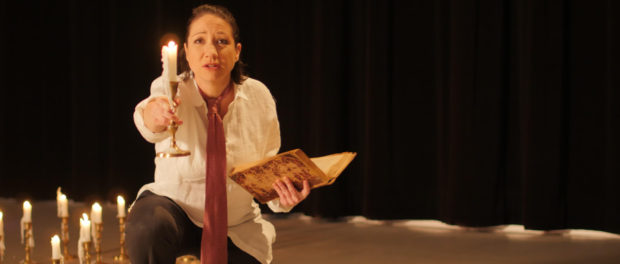La Porte: An Intimate Pagan Ritual
Beginning this Friday, Chants Libres is presenting a run of 5 performances in honour of Spanish-Québécois composer José Evangelista. His opera La Porte takes center stage at the Conservatoire’s Théâtre Rouge June 1st, 2nd, 8th, 9th and 10th. La Porte will not give you a taste of what it’s like to be at The Met; conceived for only two performers, it’s a 45-minute monodrama for voice and percussion that aims for magical intimacy, not grandeur and pomp.
In between rehearsals of La Porte at the airy, elegant Conseil des Arts de Montréal building, performers mezzo soprano Ghislaine Deschambault and percussionist Huizi Wang took some time to talk to me about the challenges and opportunities offered by Evangelista’s Opéra à deux.
Conor Coady (CC): The media package makes this opera sound like some sort of occultist religious event. What’s with the description of it as a pagan ritual? Is the audience headed for some sort of mystical experience or am I being fooled by a PR stunt?
Ghislaine Deschambault (GD): No, you’re not being fooled. There’s something about the intimacy of this piece that strikes me as pagan, with me telling stories by candlelight – pagan doesn’t seem like the wrong word.
Huizi Wang (HW): Can I just say how much I love the candles as part of the piece?
CC: What’s up with the candles?
HW: The percussion sets the mood at the opening, then drama surrounds the telling of multiple stories by the same narrator, who takes the persona of the characters in the story he’s telling.
GD: The peasant-narrator is trying to convince the gatekeeper to let him through La Porte. He tries all sorts of different narrative approaches to distract and seduce the gatekeeper and find a way through. Different sections have me singing as a knight, a king, a bird… The bird is a lot of fun.
HW: It’s kind of like Scheherazade. You tell stories as if your life depended on it. I won’t spoil the punch, but as you tell your stories, the candles are slowly burning…
CC: How tricky is the theatrical element is in what you’re doing Ghislaine? You mentioned it was a very, very intimate setting for this piece
GD: Well, the staging puts great pressure on me to get every gesture, every look just right. One glance in the wrong direction and you can lose the audience. With just the two of us, there’s nowhere to hide.
CC: So would you say the theatrical element to be managed is the toughest aspect of the performance?
GD: It’s a big challenge but I love the theatrical element. Of course it doesn’t make it easier to sing technically well while acting out different stories. But who doesn’t love stories? I have to admit that this piece reminds me in strange way of Bugs Bunny.
CC: You’re a fan of Looney Toons?
GD: Yes, I remember loving the way there’s such an organic connection between the storytelling and the music when you’re watching Bugs Bunny; it’s not clear whether the characters are reacting to the soundtrack or creating it with their actions. There’s something similar happening with La Porte. It’s so organically written.
CC: For classical music nerds like me, would you be able to point to Évangelista’s influences, or to other works that might help to situate the Opera in our ears?
GD: Well, Évangelista was influenced by music from the Middle-East, but his language is very much his own.
HW: From the point of view of the percussionist, there are links to be made with Québec composer Claude Vivier. My teacher said something interesting: percussionists provide rhythmic color. We’re not only providing the beat but also the atmosphere.
CC: And there are similarities between Vivier and Evangelista?
HW: Yes, I think so. And what is a nice challenge about this piece is the use of melodic percussion instruments, not just the skin-based or wood-based sounds that provide beat. So some singing sounds that work together with what Ghislaine is singing.
CC: So there are moments where you’re almost singing together?
GD: Well, I think it’s more that we provoke each other. Something the percussion sets the stage and pulls the singer into a different musical space, but there’s constant interplay between us.
CC: Did it feel like a duel in rehearsal before it started feeling like a dialogue?
GD: (laughs) It took a while, but now we’re really on the same page.
HW: You know, there is no simple time signature in 2/4 or 3/4, so getting ourselves on the same page took some time at the start.
GD: This is a contemporary piece. Sometimes in modern vocal music, the language and the music, they don’t go so well together. That’s not a problem with La Porte. It’s one of the main strengths of the piece. The percussion sets the stage, the language itself fits well with the musical score and the staging makes the entire spectacle very approachable. It’s not a piece to be scared of.
CC: I was worried I wouldn’t be able to persuasively describe a two-person crew performing an opera by a contemporary Québécois composer to Montreal Rampage readers, who I imagine to be mostly curious, friendly and possibly nerdy, happy hipsters. I think I’ll go with scéance-like multi-character, melodically percussive intimate pagan storytelling ritual. It sounds like a pretty good time on a Friday or Saturday night.
HW: Hah! I’m glad this is your job, not mine!
La Porte runs for 5 shows between June 1-10 at the Conservatoire de Montréal’s concert hall, 4750 Henri-Julien






